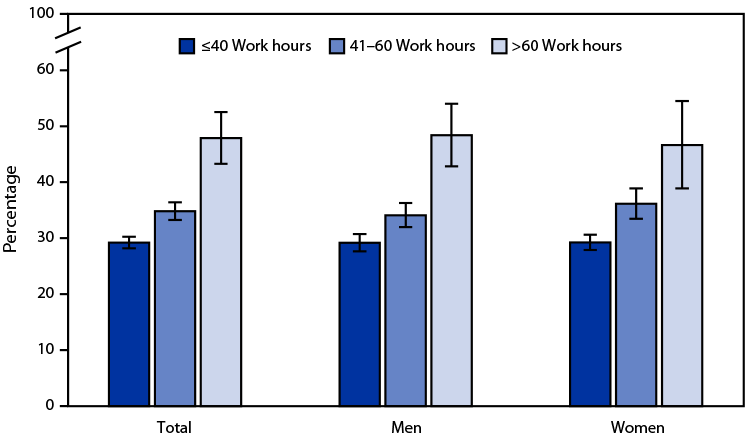QuickStats: Percentage* of Employed Adults Aged ≥18 Years Who Slept <7 Hours per 24-Hour Period,† by Sex and Number of Work Hours per Week§ — United States, 2022
Weekly / April 25, 2024 / 73(16);385
Altmetric:

* Estimates were based on household interviews of a sample of the civilian, noninstitutionalized U.S. population, with 95% CIs indicated by error bars.
† Based on a response to the question, “On average, how many hours of sleep do you get in a 24-hour period?”
§ Based on a response to the question, “How many hours did you work last week at all jobs or businesses?”
In 2022, the percentage of employed adults who slept <7 hours on average during a 24-hour period increased with the number of hours worked per week, including 29% among those who worked ≤40 hours, 35% among those who worked 41–60 hours, and 48% among those who worked >60 hours per week. The patterns were similar for men and women.
Supplementary Table: https://stacks.cdc.gov/view/cdc/153722
Source: National Center for Health Statistics, National Health Interview Survey, 2022. https://www.cdc.gov/nchs/nhis/index.htm
Reported by: Imelda Wong, PhD, iwong@cdc.gov; Abay Asfaw, PhD; Roger Rosa, PhD.
Suggested citation for this article: QuickStats: Percentage of Employed Adults Aged ≥18 Years Who Slept <7 Hours per 24-Hour Period, by Sex and Number of Work Hours per Week — United States, 2022. MMWR Morb Mortal Wkly Rep 2024;73:385. DOI: http://dx.doi.org/10.15585/mmwr.mm7316a6.
For more information on this topic, CDC recommends the following link: https://www.cdc.gov/sleep/about_sleep/sleep_hygiene.html
MMWR and Morbidity and Mortality Weekly Report are service marks of the U.S. Department of Health and Human Services.
Use of trade names and commercial sources is for identification only and does not imply endorsement by the U.S. Department of
Health and Human Services.
References to non-CDC sites on the Internet are
provided as a service to MMWR readers and do not constitute or imply
endorsement of these organizations or their programs by CDC or the U.S.
Department of Health and Human Services. CDC is not responsible for the content
of pages found at these sites. URL addresses listed in MMWR were current as of
the date of publication.
All HTML versions of MMWR articles are generated from final proofs through an automated process. This conversion might result in character translation or format errors in the HTML version. Users are referred to the electronic PDF version (https://www.cdc.gov/mmwr) and/or the original MMWR paper copy for printable versions of official text, figures, and tables.
Questions or messages regarding errors in formatting should be addressed to mmwrq@cdc.gov.